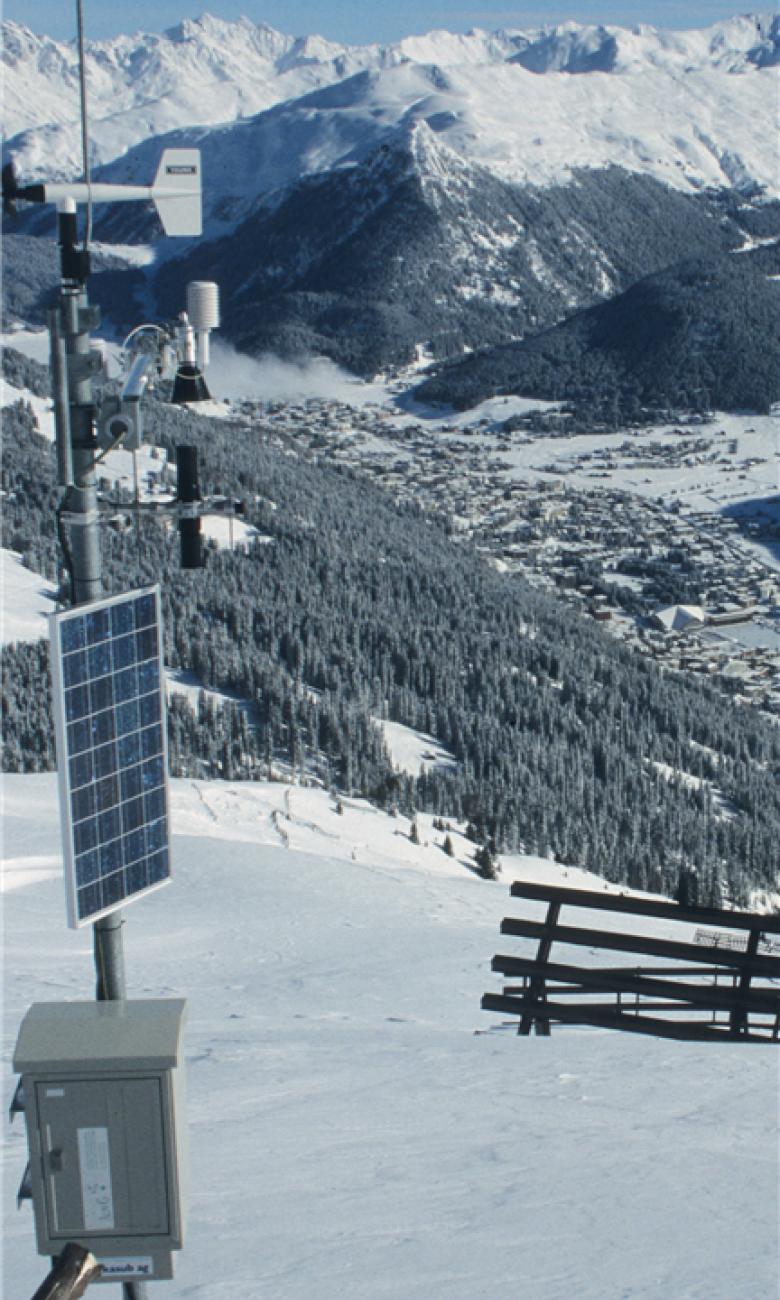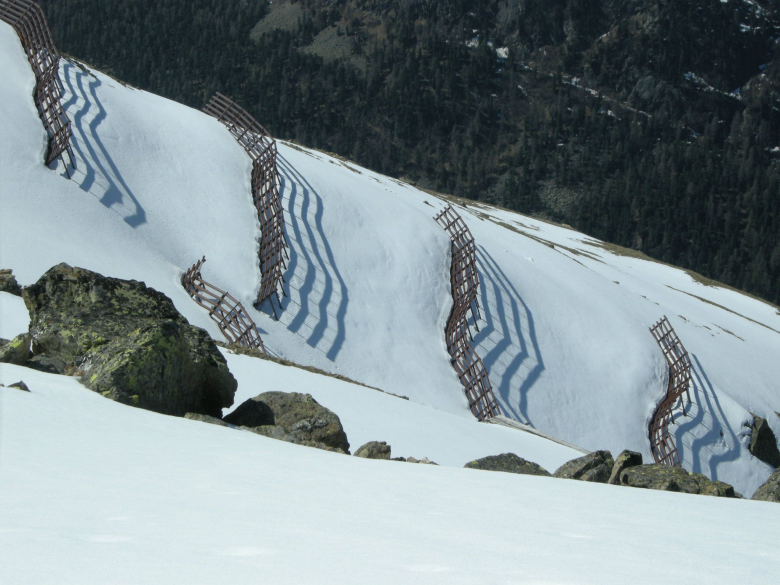Avalanche risk management included in world heritage
Knowledge of avalanches and avalanche protection is a vital tradition in Switzerland. Since November 2018, avalanche risk management has been added to the UNESCO list of the intangible cultural heritage of humanity. The inclusion was based on a joint application submitted by Switzerland and Austria. But what exactly does avalanche risk management mean?
Avalanche management: a long tradition
The concrete bunker perched high in the mountains of the commune of Arbaz in the canton of Valais is a special type of construction: cameras are positioned behind small hatches, and radar equipment behind open windows is aimed at the opposite side of the mountain. An avalanche hurtles at 160 kilometres per hour towards the bunker. The powder cloud swallows the building within seconds. In the basement of the bunker, scientists observe the snow mass via webcam. Thanks to the test site in Arbaz, they can better understand the avalanches and optimise protective measures.
Knowledge of the origin of avalanches and how to protect against them has been handed down in the Alps for centuries. For example, the inhabitants of Leukerbad built an 80-metre-long wall as far back as the year 1600 in order to divert avalanches. Today, extensive forests, avalanche barriers, galleries and other protective structures protect settlements and traffic routes from avalanches. UNESCO has included avalanche risk management on its list of the intangible cultural heritage of humanity. "It may be an intangible asset, but for a mountainous country like Switzerland avalanche risk management is vital for survival and has always been a constituent element of cultural identity," writes the WSL Institute for Snow and Avalanche Research (SLF).

Avalanche risk management developed gradually in tandem with the history of avalanche incidents. "The biggest developments have always taken place after major catastrophic avalanches," said Jürg Schweizer, head of SLF, in an interview with Swiss Radio and Television (SRF). One of these avalanche winters occurred in 1887/1888, with more than 1,000 avalanches reported in Switzerland, killing 49 people and over 600 animals. The regions most severely affected were northern and central Graubünden, Ticino and the Goms region of Valais. After the disaster, galleries, tunnels and avalanche barriers were built to protect the railway line.
The forest has always had an important protective function, which is why avalanche protection used to be the responsibility of forest rangers. From the 1930s onwards, businesses and mountain railway operators became increasingly involved in avalanche risk management, says Schweizer. Businesses and the mountain railways were keen to promote tourism and wanted to keep the railways in operation in winter as well. The Commission for Snow and Avalanche Research was founded in 1931. The commission, composed of representatives from forestry, hydrology, the railways and power stations, aimed to improve avalanche protection measures. It was the forerunner of the first snow and avalanche research laboratory in Davos, from which the SLF was created in 1942.
Avalanches with catastrophic consequences
During the avalanche winter of 1950/1951, around 100 people died in Switzerland and over 1,000 buildings were destroyed. More than 1,000 avalanches fell in the space of three days in January 1951. After this catastrophe, the SLF intensified research into avalanche protection. New protective measures were taken in many places. In addition, the SLF expanded its cooperation with the Swiss Meteorological Institute (SMI) in order to increase the reliability of the avalanche bulletin. The avalanche bulletin contains a forecast of the avalanche danger for the Swiss Alps, Liechtenstein and the Jura. It is currently published twice daily and is mainly used by avalanche and security services and by snow sports enthusiasts.
Another avalanche winter occurred in 1999, when an unusually large amount of snow fell in a short space of time in February. Hundreds of avalanches thundered down into the valleys within a few days. Galtür in Austria was particularly hard hit, with 31 fatalities. Twelve people died in avalanches in Chamonix/Montroc in France, and in the village of Evolène in the canton of Valais the avalanches claimed a further 12 lives. In total, there were around 1,200 avalanches with 17 fatalities in Switzerland. As a result of the disaster, SLF experts developed an intercantonal early warning and crisis information system.

Various types of avalanche protection
Various structural protective measures have been put in place to prevent the triggering of avalanches and protect settlements in the valleys. The most commonly used type of avalanche barrier stabilises the snowpack by means of supporting structures anchored firmly in the ground. In this way, vast areas in the valleys below can be protected. After the avalanche winter of 1950/1951, old retaining walls were replaced in many places by more efficient protective structures made of steel, aluminium, wood, wire cables and concrete. There are a total of around 500 kilometres of such defensive structures in Switzerland.
In terms of area covered, the forest is the most important avalanche protection. As some of the snow is collected in the treetops, the temperature and wind conditions in the forest are more balanced and the tree trunks support the snowpack, the snowpack in the forest is more stable than in the open.

Temporary protective measures
Controlled blasting can artificially trigger avalanches to temporarily secure potential starting zones and avalanche tracks and prevent major avalanches. This is increasingly done with permanently installed blasting systems which can trigger an avalanche from a safe distance regardless of the weather and at any given time.
If traffic routes, settlements or ski resorts are at a high level of risk, local security services can issue warnings, close the area or even initiate evacuations. For emergency planning, the specialists rely on avalanche hazard maps, among other things. The maps show the danger zones for settlements as well as the frequency and intensity of avalanche activity in a specific area. If an area is marked as 'at serious risk', construction is prohibited.
The Swiss experts have been pursuing an integral approach to avalanche risk management for about 15 years, employing a combination of structural and organisational measures to minimise the risk of avalanches.
Snow monitoring from the air
Drones are not only used to rescue avalanche victims, but also for avalanche research.
For example, scientists can use the images captured by drones to create digital surface models that can be used to determine the depth of snow deposits. "With this method, avalanches can be accurately and efficiently documented without having to access dangerous terrain on foot," says SLF expert Yves Bühler.




